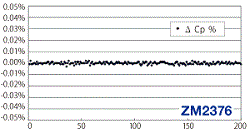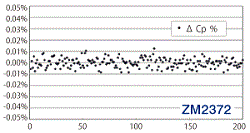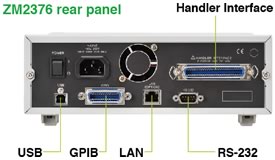
|
High-precision benchtop impedance measuring
instrument suitable for evaluation of electrical parts
and batteries
|

|
Wide measurement frequency
range
|

|
|
|

|
The ZM2371 and ZM2372 (both max. frequency of 100kHz) are
suitable for general-purpose electronic component
measurement.
The ZM2376 (max. frequency of 5.5MHz) is suitable for
measuring high frequency components such as small
inductances used in smartphones.
The big advantage of the ZM series is that it can measure
from a low frequency of at least 1mHz.
One method for evaluating battery characteristics is to
measure the internal impedance of the battery.
To evaluate high performance batteries such as lithium
batteries, internal impedance measurements at low
frequencies in the millihertz range are required.
|

|
Highly repeatable measurement
results
|

|
|
|

|
These are the results of 200 repeated measurements of the
same sample under the same measurement conditions.
The deviation of the measurement results of ZM2372 is about
0.01% or less, and the ZM2376 is even better.
Repeatable measurement results are crucial for impedance
measuring instruments.
|

|
 Measurement of 1nF capacitor Measurement of 1nF capacitor
|
Measurement conditions (time: 5 ms, frequency: 100 kHz,
signal level: 1 V)
Deviation of 200 measurement results
|

|

|

|
DC bias voltage (Built-in)
|

|
|
|

|
The ZM2376 has a built-in DC bias power supply of 0 to +
5V.
When measuring the internal impedance of the battery, it is
necessary to cancel the DC voltage of the battery.
By using a DC bias power supply, impedance measurement is
possible in the optimum voltage range.
|

|
DC bias voltage (External
power supplies)
|

|
|
|

|
If the voltage of the built-in DC bias power supply is
insufficient, there is an option that can be combined with
an external voltage source.
A bias voltage of up to ± 40V can be applied using a DC bias
adapter that connects directly to the ZM series output
terminals.
An external power supply for DC bias is required separately.
|

|
Automatic level control (ALC)
|

|
|
|

|
The automatic level control (ALC) function sets the measured
signal level to constant voltage or constant current.
For example, it is possible to continuously measure a
current-dependent element under the set current conditions.
|

|
Protection against
discharge
|

|
|
|

|
In a general LCR meter, if a charged capacitor is connected,
the measurement circuit may be damaged by the discharge.
The ZM series has a discharge protection function that
protects the input circuit from up to 4J of energy.
|

|
DC resistance (DCR)
measurement
|

|
|
|

|
It is possible to perform DC resistance measurements on the
winding resistance of such equipment as coils or
transformers.
The measured values of the inductance can be displayed in
the primary parameters at the same time as the DC resistance
in the secondary parameters.
|

|
Interfaces
|

|
|
|

|
|
Equipped with various standard interfaces for remote
control. Integrates into production lines and automatic
inspection systems without any additional options.
|

|
|
Interfaces
|
ZM2371
|
ZM2372
|
ZM2376
|
|
USB
|
✓
|
✓
|
✓
|
|
RS-232
|
✓
|
✓
|
✓
|
|
GPIB
|
|
✓
|
✓
|
|
LAN
|
|
|
✓
Option
|
|
Handler
|
|
✓
|
✓
|
|
|

|
|
Functions suitable
for product inspection
in parts production
plants
|

|
High speed measurement
|

|
|
|

|
|
Measurement speed is selectable from 5 levels: RAP (rapid) ,
FAST, MED, SLOW and VSLO (very slow). When set to RAP,
high-speed measurement at 2 ms (1 kHz/1 MHz) or 10 ms (120
Hz) can be performed. This high-speed, high-precision LCR
meter will help to improve the measurement efficiency of
production lines and automatic inspection equipment.
|

|
Contact check function
|

|
|
|

|
Triggered synchronous
drive
|

|
|
|

|
This function can be used to drive a sample for a period of
time while contact is being made.
When performing measurements of large-capacity capacitors,
it is possible to reduce the damage caused by the contact by
removing the sample.
For samples with hysteresis characteristics, when
measurements are performed in a short period of time, the
measured values have larger fluctuations. By using triggered
synchronous drive, the relationships between the time and
the phase of the drive signal applied to each sample and the
acquired signal are made constant. This suppresses
deviations of the measured values ??and makes it possible to
significantly reduce the measurement time.
|

|
Deviation display
|

|
|
|

|
When measuring a component, a preset value can be set and
the deviation and the deviation % of the measured value
compared with the preset can be displayed.
This can be useful for making acceptance judgments against
standard component tolerance values as well as for
temperature characteristic tests.
|

|
Comparator
|

|
|
|

|
A maximum of 14* primary
parameters can be classified in bins, and measurement
results can be sorted on a set of upper and lower limits
that have been set by secondary parameters. Sorting is
possible by measured value, deviation or deviation %, and
the comparator results can be output to the handler
interface*. In addition, a
beeper can be turned on depending on the comparator results.
Using the limit determination function with the remote
control interface, is also possible to determine the upper
and lower limits (for each one set) of the primary
parameters and secondary parameters.
*ZM2371: 9
classifications max. Not equipped with handler
interface.
|

|
Multi-measurement (ZM2376
only)
|

|
|
|

|
Multi-measurement is a function used for overall acceptance
judgments by performing up to 32 steps for each sample.
Multiple measurement conditions can be set for each step
such as measurement frequency, measurement signal level,
internal DC bias, and measurement parameters.
Measurements and limit determinations can be performed based
on the set of upper and lower limits of the primary
parameters and the set of upper and lower limits of the
secondary parameters.
*This function
available only on ZM2376.
|

|
Other functions
|

|
|
|

|

|
Correction functions (Open correction, short
correction, load correction, cable length
correction)
|

|
Setting and correction value memory (32 sets,
switchable to be saved to non-volatile memory)
|

|
Voltage and current measurement function
|

|
Application software (Bundled and
download)
/english/sup/prosup/software/index.html
|

|
Sample program (C #, VB.NET) included
|

|
LabVIEW driver included (ZM2371 and ZM2372)
|

|
IVI instrument drivers included (LabVIEW drivers
automatically generated on the LabVIEW system)
(ZM2376)
|
|
|
|
|
|
|
|
|